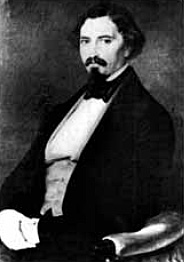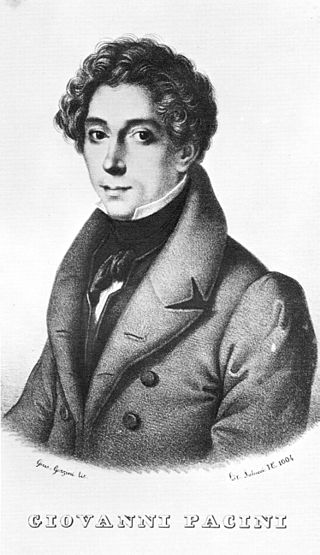
Giovanni Pacini was an Italian composer, best known for his operas. Pacini was born in Catania, Sicily, the son of the buffo Luigi Pacini, who was to appear in the premieres of many of Giovanni's operas. The family was of Tuscan origin, living in Catania when the composer was born.

Ghena Dimitrova was a Bulgarian operatic soprano. Her voice was known for its power and extension used in operatic roles such as Turandot in a career spanning four decades.
Boyko Tzvetanov is a Bulgarian operatic tenor. He was taken on as a soloist with the Sofia National Opera from 1982 to 1990. In 1991, he became a member of the ensemble of the Zurich Opera House until his retirement in 2016.

Giacomo Prestia is an Italian operatic bass,

Fanny Salvini-Donatelli was an Italian operatic soprano. She is best known today for creating the role of Violetta in Verdi's opera, La traviata, but she was also an admired interpreter of the composer's other works as well as those by Donizetti.
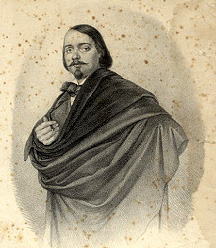
Carlo Baucardé or Boucardé (1825–1883) was an Italian operatic tenor who sang leading roles throughout Italy, as well as in London, Madrid, Paris, and New York. He is most remembered today for creating the role of Manrico in Verdi's opera Il trovatore and the title role in Donizetti's Poliuto.

Eugenia Tadolini was an Italian operatic soprano. Admired for the beauty of her voice and stage presence, she was one of Donizetti's favourite singers. During her career she created over 20 leading roles, including the title roles in Donizetti's Linda di Chamounix and Maria di Rohan and Verdi's Alzira. She was born in Forlì and studied music there and in Bologna before making her debut in Florence in 1828. She sang in all of Italy's leading opera houses, as well as in Paris, Vienna, and London before retiring from the stage in 1852. She spent her remaining years first in Naples, where she had been the Teatro San Carlo's reigning prima donna for many years, and then in Paris, where she died of typhoid fever at the age of 63. From 1827 to 1834, she was married to the Italian composer and singing teacher, Giovanni Tadolini.
Raffaele Mirate was a celebrated Italian operatic tenor who had an active career from the 1830s through the 1860s. Known for his intelligent phrasing and bright and powerful vocal timbre, he was regarded as an outstanding interpreter of the tenor roles in the early and middle period operas of Giuseppe Verdi. He notably created the role of the Duke of Mantua in the world premiere of Verdi's Rigoletto in 1851. He was also a highly regarded interpreter of bel canto roles, excelling in the operas of Vincenzo Bellini, Gaetano Donizetti, and Gioachino Rossini.
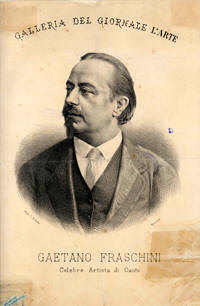
Gaetano Fraschini was an Italian tenor. He created many roles in 19th century operas, including five composed by Giuseppe Verdi. His voice was "heroic ... with a baritonal quality, ... yet Verdi and Donizetti appreciated his ability to sing softly and with subtlety." An Italian biographer has pointed out Fraschini's role in extending the longevity of Donizetti's operas, while at the same time accelerating the ascent of Verdi's repertory. He was indeed the most prominent singer who facilitated the transition from Donizetti to Verdi. Fraschini sang over one hundred roles and Verdi placed him at the top of his favorite tenors' list and described him as a "natural Manrico" for his Il trovatore. Fraschini also played a pivotal role in the success of many operas by Pacini and Mercadante.

Maria Spezia-Aldighieri (1828–1907) was an Italian operatic soprano who had an active international career from 1849 up into the 1870s. She excelled in the coloratura soprano repertoire and was particularly admired for her portrayals in the operas of Giuseppe Verdi. Her performance of Violetta in Verdi's La traviata at the Teatro San Benedetto in Venice in 1854 is credited with popularizing the opera after it had initially flopped at its premiere in 1853. She was married to baritone Gottardo Aldighieri and is the great grandmother of singer George Aaron.
Eugenio Cavallini was an Italian conductor, composer, violinist, and violist. In 1833 he became first violinist of the orchestra at La Scala, a post he held through 1855. He also served as a conductor at La Scala, notably leading the world premieres of Gaetano Donizetti's Lucrezia Borgia (1833), Donizetti's Gemma di Vergy (1834), Donizetti's Maria Stuarda (1835), Saverio Mercadante's Il giuramento (1837), Mercadante's Il bravo (1839), Giuseppe Verdi's Oberto (1839), Verdi's Un giorno di regno (1840), Donizetti's Maria Padilla (1841), Verdi's Nabucco (1842), Verdi's I Lombardi alla prima crociata (1843), Verdi's Giovanna d'Arco (1845), Federico Ricci's Estella di Murcia (1846), and Domenico Ronzani's Salvator Rosa (1854).
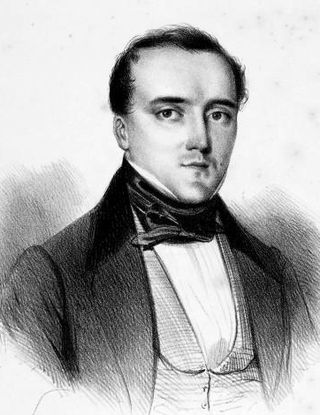
Nicolas-Prosper Dérivis was a French operatic bass. He possessed a rich deep voice that had a great carrying power. While he could easily assail heavy dramatic roles, he was also capable of executing difficult coloratura passages and performing more lyrical parts. Along with Nicolas Levasseur, he was one of the greatest French basses of his generation.
Teresa Ruggeri was an Italian operatic soprano who had an active career from the 1820s through the 1840s. In 1827 she portrayed the role of Zarele in the world premiere of Giovanni Pacini's Gli arabi nelle Gallie at La Scala in Milan. She performed in several more world premieres at that house, including Francisca in Gaetano Donizetti's Maria Padilla (1841), Anna in Giuseppe Verdi's Nabucco (1842), and Viclinda in Verdi's I Lombardi alla prima crociata (1843). Other roles she performed at La Scala included Baroness Aspasia in Gioachino Rossini's La pietra del paragone (1829), Giannetta in Donizetti's L'elisir d'amore (1835), Alisa in Donizetti's Lucia di Lammermoor (1839), The Marquise of Birkenfeld in La fille du régiment (1840), and Giovanna in Verdi's Ernani (1844) among others.

Erminia Frezzolini was an Italian operatic soprano. She excelled in the coloratura soprano repertoire, drawing particular acclaim in the bel canto operas of Gaetano Donizetti and Vincenzo Bellini. She was married to tenor Antonio Poggi from 1841 to 1846.
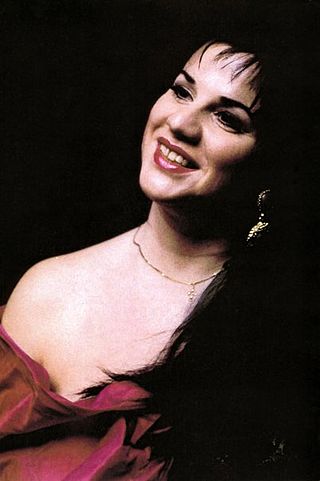
Maria Dragoni is an Italian operatic soprano active international career in major opera house from 1984 to present.

Antonio Poggi was an Italian operatic tenor who had an active international career from 1827–1848. He is best remembered for creating roles in the world premieres of operas by Gaetano Donizetti and Giuseppe Verdi. He was married to soprano Erminia Frezzolini from 1841–1846.

Angela Meade is an American operatic soprano.
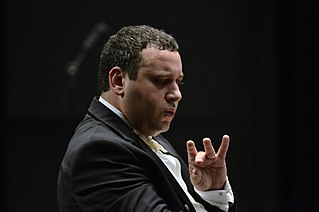
Antonino Fogliani is an Italian conductor.

Carlo Negrini was an Italian spinto tenor and creator of Gabriele Adorno in Verdi’s opera Simon Boccanegra.

Filippo Andrea Francesco Coletti was an Italian baritone associated with Giuseppe Verdi. Coletti created two Verdi roles: Gusmano in Alzira and Francesco in I masnadieri. Verdi revised the role of Germont in La traviata for Coletti, whose interpretation re-defined the role as it is known today. Coletti was, with Antonio Tamburini (1800–1876) and Giorgio Ronconi (1810–1890), one of the three leading baritones of 19th century Italy, an early model of a 'Verdi baritone'.
